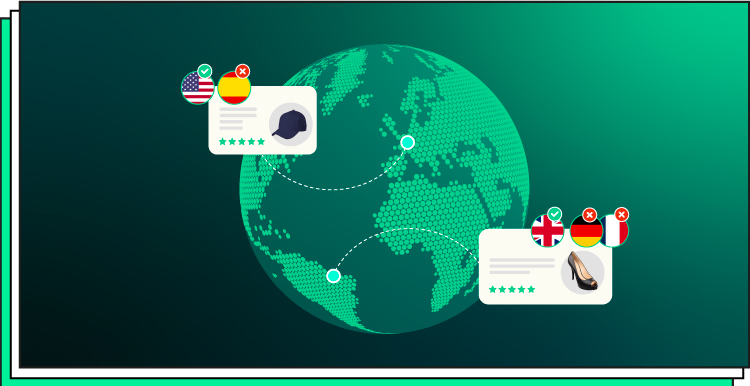eCommerce companies reaching the highest level in their local area often scale to new markets. They expand their target audience and benefit from turning into international businesses.
At first glance, it seems that entering a foreign market is a simple task. You already have a website, know how to use the promotion tools, and are sure that the products you offer are in demand in the target region. However, if everything was that simple, every second retailer could turn into a prosperous international business.
The task of entering a foreign market requires you to adjust to the demands and conditions this market dictates. The process is called e-commerce localization. It involves numerous measures essential for your business to be accepted by a new audience.
In this paper, we will talk about ecommerce localization and give you practical advice on how to localize your online business. We will take you through the essential aspects of ecommerce localization and highlight the benefits of such a decision. At the end of the article, we will share our perspective on ecommerce localization best practices and the best outcomes you can get. Keep reading if you are determined to conquer new markets.
What Ecommerce Localization Is
E-commerce localization stands for the process of customizing an e-commerce store to meet the needs of a new market. For example, if an American brand decides to scale to Europe, it will need to explore the European market, user habits, preferences, and economic conditions. By doing so, they will get a better understanding of the current market state, prices for similar products/services in this region, favorite payment options of the local citizens, etc.
Then, the business will have to adjust the store’s language to each particular country by offering the English website version as well as a localized website. Hereafter, product descriptions and details should be adjusted to the local language and culture, either manually or automatically. Possibly, the business will also have to make new product images after exploring the design trends of the given market.
You may wonder what will happen if the business skips all of these steps. The answer is simple — their profit will suffer. Inconvenient payment methods or the methods users are unfamiliar with will alienate the audience from making an order and increase the shopping cart abandonment rate. The foreign measurement units will make it harder for clients to understand the product’s size, lengths, weight, etc. On top of that, an online store that is not customized may repel the audience intuitively. They won’t feel comfortable when exploring the products and will be likely to leave the site in search of a better option.
To prevent such a scenario, international businesses should perform localization. Below, you can see an example of how McDonald’s localized the website. The first image shows the McDonald’s menu presented on the US site. Another image represents the way it looks on their Polish site. As you see, the difference is crucial.


Main Benefits of Ecommerce Localization Process
E-commerce localization is a must if you plan to establish yourself in the market as a long-term player. Here are some of the main benefits that you can get from localizing your site:
- Scale up. Localized websites ensure faster growth. By localizing the site, you will smoothly integrate your business into the foreign market. One of the studies revealed that ecommerce businesses localizing prices experience a 30% faster growth than those who refrain from this strategy.
- Higher metrics. eCommerce metrics are used to measure one’s success and performance. Among the crucial ecommerce metrics, we can name conversion and retention rates. After you mind the preferences of your customers and localize the website, they will engage with your website more. This will result in an increase in ecommerce metrics, higher customer loyalty, and a positive impact on profit.
- Personalization. One of the biggest ecommerce trends is the trend for personalization. Because of the vast competition, it becomes more and more complicated to win user attention. The solution to this challenge is to make the customer experience personalized and memorable. It can result in 10-15% higher conversion and higher profits accordingly. Yet, personalization will be impossible if you do not prepare your e-commerce store for the requirements of the target market.
- Lower shopping cart abandonment rate. E-commerce stores that are not localized but look pretty can indeed attract user attention and make them put products into their cart. Some of the customers will even proceed with the order till the checkout. But at the end of the checkout process, they will see that there is no convenient payment method or affordable shipping option on the list. This will make them leave their cart abandoned. Localized websites ensure a high level of convenience for your customers and help you reduce the number of abandoned carts and grow international sales.
- Build a strong brand identity. By entering the international market, you increase client trust in your business. It’s easier to rely on a company that is represented in many countries and has done business for years. If you decide to localize the website for a particular country or region, you will show your clients that their shopping experience matters to you.
- Rank high on Google or other search engines. The work of a search engine won’t be so perfect if it doesn’t use AI-powered algorithms. Thanks to this technology, a user sees the best search results on the top. The first places in the ranking are given to the results that best match user interests, location, language, currency, etc. By localizing the website, you get better chances to end up in the top results for the local audience.

7 Aspects of an Ecommerce Store to Be Localized
More than 90% of customers say they won’t purchase from an e-commerce website they are unfamiliar with. To increase the feeling of familiarity with your site, you can localize the following aspects:
Currency
Localized websites display prices in the local currency. Imagine that a potential client from France goes to your website to check the product price. The client sees that the product they are looking for costs $20. How much does it cost in euros? The customer won’t be happy to spend their time searching for exchange rates and calculating the product price in their local currency. What’s more, if the payment is processed by a US-based bank, the client will get a high transaction fee they will not be happy about, too. In this situation, you are at risk of losing the potential client.
The opportunity to check prices in local currencies should be provided by default. You can ensure this feature with the help of e-commerce localization. By referring to this process, you will configure your ecommerce store in such a way that the local currency will be automatically displayed to the local customers. Besides, a user will also have the opportunity to select another currency manually.
Images
Cultural differences from country to country can affect the way users perceive images. In some countries, the average commercial photoshoot may be perceived as offensive or irrelevant. What’s more, the same product may be used differently in different countries, depending on the weather, climate, economy, culture, and other conditions of the region.
Not always, it is required to localize imagery. However, this can be an exciting way to test how users respond to the standard vs. localized product images.
Payment Options
One payment gateway or processor may be extremely popular in some regions, while in other regions, it is rarely used. The same applies to payment methods in general. For example, US citizens feel okay paying for an order online with Google Pay or Apple Pay. Meanwhile, people living in Eastern Europe are more comfortable with the cash-on-delivery method.
When localizing the website, integrate the most popular payment methods in the target region. For this, conduct a market analysis and discover what options the local Internet users prefer.
Customer Support
No worries — there is no need to hire a lot of customer support specialists in each country. We have a better idea of how you can localize client service. The use of AI-powered conversational chatbots can be the key to satisfying client needs in their own language and manner. Also, you can use AI-powered translation tools to automatically display client reviews in the local language.
Pricing
On the one hand, the purpose of pricing localization is to help you maintain the profit margin. On the other hand, before setting a price, you should consider the living standards of the country that is your destination. If the potential revenue does not match your expectations, try to look for other target markets that can give you broader opportunities. In fact, it can be a more profitable decision than entering an unstable market and putting your business at stake.
Another factor that influences website localization is the cost of taxes, logistics, and transportation services in the region. All this has a tremendous impact on your profit. To evaluate if it is worth the try, you should be well acquainted with the regulations and rules of the target country.
Domain
As a rule, businesses choose the .com domain for their main website. According to Domain Name Stat, .com serves more than 36% of all registered domains, which stands for more than 245,000,000 sites. To customize your main domain, you can use the following strategies:
- Add a country code to the top-level domain. For example, if your site address is business.com for the US market, your UK-based site may be business.co.uk.
- Create subdomains. In this case, a localized website is created as a subdomain by adding the abbreviation to the name of the main domain. It looks as follows: uk.business.com.
- Create subfolders. This is the least common strategy of the three. It involves adding an additional folder to your main site. The folder will correspond to the country’s name that you target. For instance, business.com/uk/
Product Descriptions
Ecommerce localization allows online shoppers to read about the product in their native language. More than 75% of clients demand sites to provide information in their language. What’s more, they often refrain from purchasing from English-only sites. Obviously, it’s quite a tedious task to translate each product description manually. What’s more, this process can result in typos, misspellings, and mistakes. To save time for your content managers, you can integrate the feature of automated translation into your e-commerce site.
Forbytes has 12 years of experience in creating business solutions for ecommerce clients. Among these, there are many cases of developing business automation tools, including auto-translation tools. Such tools can be integrated with your ecommerce store and can optimize not only language translation but other back-office processes as well.
Ecommerce Localization Best Practices
Here are some of the most effective tips that the Forbytes team implements in our ecommerce software development projects.
- Be aware of the peculiarities of the local culture. For example, certain colors, plants, animals, etc. can symbolize different things in different regions. If you implement creative marketing ideas, double-check if the elements are not misinterpreted in the target country.
- Maintain your identity. When localizing the website, you should not go too far. Do not change your brand vision upside down — your brand should look consistent regardless of the country. This means that no matter the location, a user should always recognize your brand by tone, logo, brand colors, etc.
- Do search engine optimization of the content to the local trends. In different countries, people formulate their search queries differently. Conduct SEO research and collect the most popular keywords for your niche to further integrate them into your marketing content.
How Can Forbytes Help You with Ecommerce Localization?
In this article, we guided you through different aspects of e-commerce localization. You can include the article’s main points in your checklist for entering the target market. Of course, the localization process is not a one-time activity that can be done in a day or a few. Frequently, it presupposes the ongoing use of automation tools that ease translation and require less human intervention.
Forbytes is a professional software development company that specializes in ecommerce development. We built diverse products for our clients, from back-office management systems to trendy sites and apps. Also, we helped businesses launch, configure, and optimize transformational processes like cloud migration, data migration, ecommerce localization, etc.
Contact us anytime you need help with localizing your ecommerce website and grasping the requirements of the local market.

Our Engineers
Can Help
Are you ready to discover all benefits of running a business in the digital era?

Our Engineers
Can Help
Are you ready to discover all benefits of running a business in the digital era?









